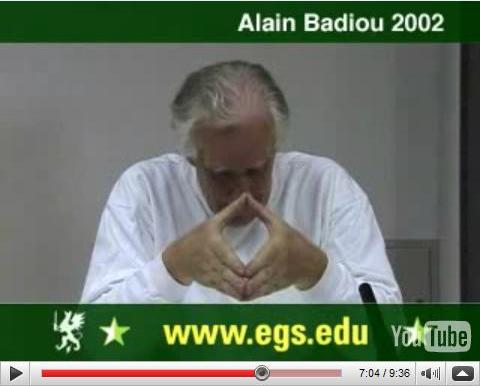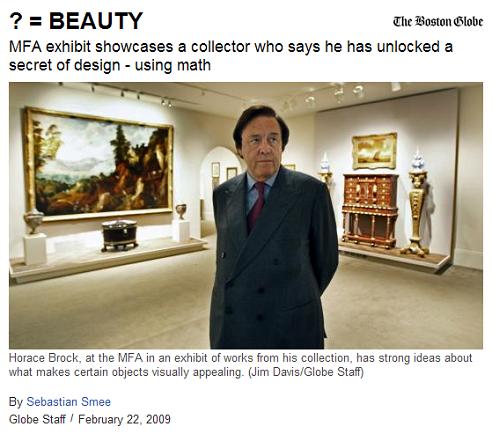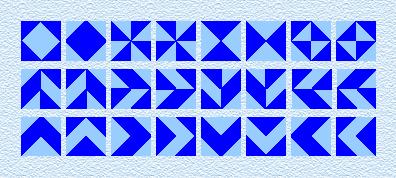Friday, February 27, 2009 7:35 PM
Mathematics and Narrative:
"... an epoch-making event so generally ignored that we have to be reminded of it at every moment. The fact is that around 1910 a certain space was shattered... the space... of classical perspective and geometry...."This suggests, for those who prefer Harvard's past glories to its current state, a different Raum from the Zeit 1910.
-- Page 25 of The Production of Space (Blackwell Publishing, 1991)
Friday, February 27, 2009 10:12 AM
Annals of Philosophy:
Malcolm, N. (1999) "Wittgenstein: A Memoir," in F.A. Flowers (ed.) Portraits of Wittgenstein, vol. 3, Bristol: Thoemmes Press, pp. 60-112The lasting significance here is perhaps in the page numbers.
Thursday, February 26, 2009 8:04 PM
Sticks Nix, continued:
Thursday, February 26, 2009 9:00 AM
Ash Wednesday, continued...
|
"That summer of '68, I was in a vast crowd in London's sunlit Hyde Park listening to Pink Floyd's free concert: One inch of love is one inch of shadow -- Roger Cohen, May 28, 2008, on 1968, "The Year That Changed the World" "Much of Badiou's life has been shaped by his dedication to the consequences of the May 1968 revolt in Paris." -- European Graduate School biography |

| We live in a constellation Of patches and of pitches, Not in a single world, In things said well in music, On the piano and in speech, As in a page of poetry— Thinkers without final thoughts In an always incipient cosmos. The way, when we climb a mountain, Vermont throws itself together. -- Wallace Stevens, from "July Mountain" |

Thursday, February 26, 2009 12:30 AM
Dead Time, Part III:
Thursday, February 26, 2009 12:00 AM
Dead Time, Part II:

From
the publisher:About the AuthorPatrick
McGee is McElveen Professor of English at Louisiana
State University, Baton Rouge.
Table of ContentsRelated CategoriesFound in: Cultural Theory, Literary Theory & Criticism, Ethics |
Wednesday, February 25, 2009 11:30 PM
Dead Time, Part I:
Wednesday, February 25, 2009 12:00 PM
Mardi Gras Numbers and...




Tuesday, February 24, 2009 1:00 PM
Mathematics and Narrative, continued:

| From Wallace
Stevens: A World of Transforming Shapes, by Alan D. Perlis,
Bucknell University Press, 1976, p. 117: ... in 'The Pediment of Appearance,' a slight narrative poem in Transport to Summer... A group of young men enter some woods 'Hunting for the great ornament, The pediment of appearance.' Though moving through the natural world, the young men seek the artificial, or pure form, believing that in discovering this pediment, this distillation of the real, they will also discover the 'savage transparence,' the rude source of human life. In Stevens's world, such a search is futile, since it is only through observing nature that one reaches beyond it to pure form. As if to demonstrate the degree to which the young men's search is misaligned, Stevens says of them that 'they go crying/The world is myself, life is myself,' believing that what surrounds them is immaterial. Such a proclamation is a cardinal violation of Stevens's principles of the imagination. |
| A discussion of Stevens's late poem "The Rock"
(1954) in Wallace
Stevens: A World of Transforming Shapes, by Alan D. Perlis,
Bucknell University Press, 1976, p. 120: For Stevens, the poem "makes meanings of the rock." In the mind, "its barrenness becomes a thousand things/And so exists no more." In fact, in a peculiar irony that only a poet with Stevens's particular notion of the imagination's function could develop, the rock becomes the mind itself, shattered into such diamond-faceted brilliance that it encompasses all possibilities for human thought: The rock is the gray particular of man's life, |
B. J. Leggett, "Stevens's Late Poetry" in The Cambridge Companion to Wallace Stevens-- On the poem "The Rock":
"... the barren rock of the title is Stevens's symbol for the nothingness that underlies all existence, 'That in which space itself is contained'.... Its subject is its speaker's sense of nothingness and his need to be cured of it."


Monday, February 23, 2009 2:22 PM
To Thank the Academy:
| Project
MUSE -- ... and interpretations, "any of the Zingari shoolerim [gypsy schoolchildren] may pick a peck of kindlings yet from the sack of auld hensyne" (FW 112.4-8). ... -- Patrick McGee, "Reading Authority: Feminism and Joyce," MFS: Modern Fiction Studies-- Volume 35, Number 3, Fall 1989, pp. 421-436, The Johns Hopkins University Press |
"The ulterior motive behind this essay ["Reading Authority," above], the purpose for which I seize this occasion, concerns the question or problem of authority. I stress at the outset my understanding of authority as the constructed repository of value or foundation of a system of values, the final effect of fetishism-- in this case, literary fetishism. [Cf. Marx, Das Kapital] Reading-- as in the phrase 'reading authority'-- should be grasped as the institutionally determined act of constructing authority...."Wikipedia:
"[In Peter Pan] Smee is Captain Hook's right-hand man... Barrie describes him as 'Irish' and 'a man who stabbed without offence'...."Background: In yesterday's morning entry, James Joyce as Jesuit, with "Dagger Definitions."
A Jesuit in Portrait of the Artist as a Young Man:"Brock, who has a brisk mind, is a man on a mission. He read mathematical economics and political philosophy at Princeton (he has five degrees in all) and is the founder and president of Strategic Economic Decisions Inc., a think tank specializing in applying the economics of uncertainty to forecasting and risk assessment.
But phooey to all that; Brock has deeper things to think about. He believes he has cracked the secret of beautiful design. He even has equations and graphs to prove it."
"When may we expect to have something from you on the esthetic question?"
Beckett Bethicketted:
"Our entanglement in the wilderness of Finnegans Wake is exemplified by the neologism 'Bethicket.' This word condenses a range of possible meanings and reinforces a diversity of possible syntactic interpretations. Joyce seems to allude to Beckett, creating a portmanteau word that melds 'Beckett' with 'thicket' (continuing the undergrowth metaphor), 'thick' (adding mental density to floral density).... As a single word 'Bethicket' contains the confusion that its context suggests. On the one hand, 'Bethicket me for a stump of a beech' has the sound of a proverbial expletive that might mean something like 'I'll be damned' or 'Well, I'll be a son of a gun.'...."
-- Stephen Dilks
At the Oscars, 2009
Sunday, February 22, 2009 4:07 PM
Design Theory:

Aesthetic satisfaction comes from an apprehension of how those themes and transformations relate to each other, or of what Brock calls their 'relative complexity.' Basically-- and this is the nub of it-- 'if the theme is simple, then we are most satisfied when its echoes are complex... and vice versa.'"
Related material:


Sunday, February 22, 2009 11:00 AM
Today's Sermon:

From the
Harvard
Graduate School of Design--
Call
for Entries:
The Space of Representation
DEADLINE FEBRUARY 27, 2009 8PM EST
Saturday, February 21, 2009 10:10 AM
Annals of Religion:

| "Men’s curiosity searches past and future And clings to that dimension. But to apprehend The point of intersection of the timeless With time, is an occupation for the saint...." -- T. S. Eliot, Four Quartets |


Friday, February 20, 2009 11:01 PM
ART WARS continued:


Friday, February 20, 2009 6:00 PM
Annals of Science:


Friday, February 20, 2009 2:01 PM
ART WARS continued:
| The following meditation was inspired by the recent fictional recovery, by Mira Sorvino in "The Last Templar," of a Greek Cross -- "the Cross of Constantine"-- and by the discovery, by art historian Rosalind Krauss, of a Greek Cross in the art of Ad Reinhardt. |

Note that in applications, the vertical axis of the Cross of Descartes often symbolizes the timeless (money, temperature, etc.) while the horizontal axis often symbolizes time. T.S. Eliot:
"Men’s curiosity searches past and future And clings to that dimension. But to apprehend The point of intersection of the timeless With time, is an occupation for the saint...." |
| "In suggesting that the success [1] of the
grid is somehow connected to its structure as myth, I may of course be accused of stretching a point beyond the limits of common sense, since myths are stories, and like all narratives they unravel through time, whereas grids are not only spatial to start with, they are visual structures that explicitly reject a narrative or sequential reading of any kind. [1] Success here
refers to
three things at once: a sheerly quantitative success, involving the number of artists in this century who have used grids; a qualitative success through which the grid has become the medium for some of the greatest works of modernism; and an ideological success, in that the grid is able-- in a work of whatever quality-- to emblematize the Modern." -- Rosalind Krauss, "Grids" (1979) |
Thursday, February 19, 2009 7:07 AM
Graphic Design Notes (review):


"That old Jew gave me this here." -- A Flag for Sunrise |

Wednesday, February 18, 2009 11:30 AM
Woman and Her Symbols:
| "The challenge is to keep high standards of scholarship while maintaining showmanship as well." |

"One highlight of Secretary of State Hillary Clinton's first overseas trip will be a stop in China. Her main mission in Beijing will be to ensure that US-China relations under the new Obama administration get off to a positive start."
-- Stephanie Ho, Voice of America Beijing bureau chief, today
Symbol of The Positive,
from this journal
on
Valentine's Day:
Stephanie was born in Ohio and grew up in
California. She has a bachelor's degree in Asian studies with an
emphasis on Chinese history and economics, from the University of
California at Berkeley."
"She is fluent in
Mandrin Chinese."
--VOA
As is Mira Sorvino.

Those who, like Clinton, Raggio, and
Sorvino's fictional archaeologist in
"The Last Templar," prefer Judeo-
Christian myths to Asian myths,
may convert the above Chinese
"well" symbol to a cross
(or a thick "+" sign)
by filling in five of
the nine spaces outlined
by the well symbol.
In so doing, they of course
run the risk, so dramatically
portrayed by Angelina Jolie
as Lara Croft, of opening
Pandora's Box.
(See Rosalind Krauss,
Professor
of Art
and Theory at Columbia,
for scholarly
details.)

Krauss

Tuesday, February 17, 2009 1:06 PM
Mathematics and Poetry (review):
| A discussion of Stevens's late poem "The Rock"
(1954) in Wallace
Stevens: A World of Transforming Shapes, by Alan D. Perlis,
Bucknell University Press, 1976, p. 120: For Stevens, the poem "makes meanings of the rock." In the mind, "its barrenness becomes a thousand things/And so exists no more." In fact, in a peculiar irony that only a poet with Stevens's particular notion of the imagination's function could develop, the rock becomes the mind itself, shattered into such diamond-faceted brilliance that it encompasses all possibilities for human thought: The rock is the gray particular of man's life, |
